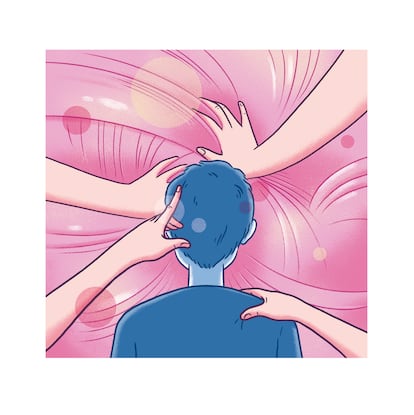Why do we like to pop plastic bubbles?
Contemporary ways of finding fulfillment are strangely conformist: ASMR videos and watching loops of repetitive actions

When bubble wrap appeared in 1957 to protect fragile objects, humanity immediately discovered another use: to pop the balls with the thumb and forefinger to hear their click, which generates a sense of satisfaction. The action was so popular that, in 2007, the Japanese brand Bandai began selling the Mugen Puchi Puchi keychain, which reproduced the sound and tactile sensation of popping the much-loved plastic bubbles.
Mugen Puchi Puchi today seems simple compared to the videos in the Oddly Satisfying category that populate Instagram and other social networks. These videos offer instant gratification in the form of sensory treats to, according to science, give the brain a necessary pause in order to keep working properly and allow us to produce more and better. They may seem like the equivalent of throwing a peanut at our most sophisticated organ, but they are as addictive as a drug, camouflaged in seemingly innocuous scenes such as a hand dicing bars of soap or sealing the edges of an endless batch of dumplings with a fork.
On the Reddit social network, the community called Oddly Satisfying is made up of more than nine million people. It cannot be a coincidence that there are so many people looking for the same thing. Researchers at the University of Swansea (United Kingdom) have spent time studying this phenomenon. The explanations do not reveal anything shocking: they tell us that watching relaxing activities facilitates the production of serotonin and dopamine, which are necessary for our bodies’ functioning. Everything is related to the sensations provided by ASMR, the acronym for “autonomous sensory meridian response.” Not everyone feels the benefits of the magic, but anyone who consumes the videos and audios that populate the Youtubesphere under the aforementioned acronym will feel some sense of well-being, however minimal.
Also benefiting are those who have found it profitable to produce these videos. Mashable.com provides tips for anyone looking to open an Oddly Satisfying video account. To begin with, they should purchase what is known as “magic sand” or foam that is used as a support for flower arrangements: there is a demand for videos of people squeezing glittery polyhedrons of the material. One example is Annette Labedzki, who makes colored Oreo cookies, fills them with frozen paint from a piping bag and then cuts them with a palette knife, which makes a very pleasant sound. We can watch the action over and over, hundreds of times: while we contemplate the making of the fictional Oreo, nothing bad can happen to us. The outside world does not exist. Isn’t that the valuable mindfulness that we hear so much about?
Although softness reigns supreme in these videos, the knife appears as an indispensable tool, cutting into shapes and blocks. Psychoanalysts would rub their hands at the appearance of this sharp object that appears here at the service of calm and well-being.
Perversely, many Oddly Satisfying videos show product manufacturing chains. Contemplating their regular rhythm is rewarding, but even more pleasant is recognizing that we don’t have to work on them. The Instagram account @Relaxify understands the appeal. It posts videos of workers painting the characteristic black lines on orange basketballs and packaging ice cream.
Watching disembodied hands cut blocks of compact colored sand, like the ones featured on @sand.isfying, is like watching someone chop bars of soft nougat. It could be profitable to open an Oddly Satisfying center with appetizing activities, from opening a pomegranate and separating its seeds, to molding pottery on a wheel.
If one thing is clear to us, it is that the contemporary ways of finding satisfaction are strangely conformist. That must please those who devise mechanisms of social control. Viewers frequently comment, “I could watch this for hours.” Be careful because, while we gawk at those videos, our awareness levels are at a minimum. Welcome to the sedation of satisfaction.
Sign up for our weekly newsletter to get more English-language news coverage from EL PAÍS USA Edition
Tu suscripción se está usando en otro dispositivo
¿Quieres añadir otro usuario a tu suscripción?
Si continúas leyendo en este dispositivo, no se podrá leer en el otro.
FlechaTu suscripción se está usando en otro dispositivo y solo puedes acceder a EL PAÍS desde un dispositivo a la vez.
Si quieres compartir tu cuenta, cambia tu suscripción a la modalidad Premium, así podrás añadir otro usuario. Cada uno accederá con su propia cuenta de email, lo que os permitirá personalizar vuestra experiencia en EL PAÍS.
¿Tienes una suscripción de empresa? Accede aquí para contratar más cuentas.
En el caso de no saber quién está usando tu cuenta, te recomendamos cambiar tu contraseña aquí.
Si decides continuar compartiendo tu cuenta, este mensaje se mostrará en tu dispositivo y en el de la otra persona que está usando tu cuenta de forma indefinida, afectando a tu experiencia de lectura. Puedes consultar aquí los términos y condiciones de la suscripción digital.










































